Who we are and
how to reach us.
South-East Brazilian
Wild Capsicum.
XVth EUCARPIA
Capsicum and Eggplant


 view poster (pdf version)
view poster (pdf version)
CLAUDIO DAL ZOVO (Associazione PepperFriends, claudiodalzovo@pepperfriends.com), GÁBOR CSILLÉRY (ESASEM), GIANNI GATTO (ESASEM)
A large number of little-known species of wild Capsicum grow in South-East Brazil.
Claudio Dal Zovo, one of the authors, made four trips (together with other Italian keens on Capsicum in 2011-2012, alone in 2013) to locate populations of these species, observe them in the wild, describe their morphological characteristics, gather a complete photographic documentation and report about the current situation.
He carried out a meticulous preparatory work by examining almost all the available literature, searching herbaria sheets of Embrapa and exchanging information with Brazilian and Argentinian botanists.
During his trips he explored known sites and other promising areas, including the protected reserves of Boracéia and Paranapiacaba; he found out and documented populations or individuals of known species and yet unclassified accessions.
The typical habitat of the endemic black-seeded South-Eastern species is the "Mata Atlântica" [a], at altitudes between 500 and 2000 m asl, in the transition zones between light and shadow (edges of roads and trails or limits of clearings).
Plants have shrub or small tree habit (up to 3 m) with long branches and vigorous suckers and sprouts [b].
Some species are almost glabrous, other very pubescent, covered with mono-pluricellular trichomes.
Flowers in most species are multiple per node, erect and geniculate at anthesis; the corolla is stellate, white with greenish/yellowish spots in the throat and purplish red spots in the petals lobes [c].
Fruits are small and roundish, as large as a pea, pendulous, green when immature [d], greenish yellow, almost translucent and deciduous when ripe [e].
Fruits of all the species are pungent, except in C.dusenii, quite hot when immature, less hot, sweet and juicy after ripening.
Seeds are black, very coriaceous [f].
Genoma is 26n (2n=2x) (not verified in C.hunzikerianum).
Flower position at anthesis, corolla colors, calyx teeth and pubescence may differs from species to species.
Few species are clearly differentiated on the basis of their morphology and habitat.
C.hunzikerianum is very different from all the other species in its habit and habitat, its leaves, flowers, fruits and lack of pubescence [a].
C.friburgense is unique for the shape and color of its corolla [b].
C.dusenii is well-differentiated for its flower, the dense pubescence, the calyx with 10 teeth of the same length and above all for the lack of pungency.
C.villosum is immediately recognizable for the very dense pubescence [c].
The population of C.pereirae which grows at Ibitipoca is well-differentiated for its habitat, the flower pendulous not geniculate, the leaves coriaceus.
Capsicum sp.9 of Caraça is unique for the linear leaves [d], the size of its flowers [e] and seeds and its geographical isolation from other Capsicum.
All these species (except C.villosum) grow in narrow areas.
Some populations found in different sites and classified as distinct species show minor differences and therefore could be ecotypes belonging to the same species, with differences caused by environmental conditions.
In other cases there are significant differences between populations assigned to the same species.
Morphological traits such as corolla color and shape, number, length and shape of calyx teeth are variable depending on climatic and growing conditions, even within the same population or in the same plant; thus sometimes it's difficult to determine to which species belongs a certain population.
It's possible to define groups of species or populations with classification issues.
The group of C.cornutum includes populations characterized by variable pubescence, calyx with 10 teeth (sometimes 5 to 9), corolla golden-spotted or completely white.
This is a heterogenous group which could include several species.
Some botanists consider C.cornutum synonymous of C.dusenii, but morphological differences are obvious and the fruits of C.dusenii are not pungent.
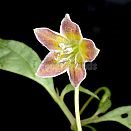
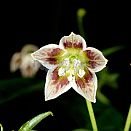
Another group includes populations with 5 teeth in the calyx, corolla with greenish/yellowish spots in the throat and purplish red in the lobes, scarce pubescence.
C.buforum and various populations identified as Capsicum sp.6 belong to this group.
Some experts think that these populations match C.mirabile described in Flora Brasiliensis, but the recent literature contains conflicting opinions about the correct name to use.
The group of C.schottianum includes populations with calyx toothless and corolla with greenish/yellowish spots, sometimes with more or less obvious purplish red component which may be absent or present even in flowers from the same plant at different times.
Calyx has 5 nervatures which sometimes originate small teeth.
C.campylopodium Sendtn. shows minor differences; it could be an ecotype of C.schottianum.
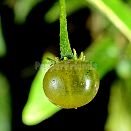
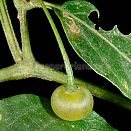
The populations of C.recurvatum spread in the area at South and East of São Paulo (Parque Botelho, Morretes) presents great variability in the shape, orientation, number and length of calyx teeth.
Sometimes well-formed and curved backwards, in other cases reduced or almost absent, even in plants growing side by side.
A population found at Paranapiacaba has similar features.
Corolla has greenish/yellowish or pure green spots.
Two populations of C.pereirae in two far apart areas and different habitat share common features such as pendulous not geniculate flower and toothless calyx.
The habitat at Ibitipoca ("gruta humida") is the most peculiar among all those visited, a kind of oasis inside an arid park, with scarce natural light and high humidity.
The population near Castelo was not found, but its habitat and features described in literature look somehow different from those of the population of Ibitipoca.
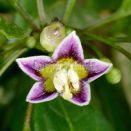
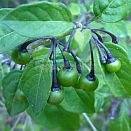
C.caatingae is a special case. When we saw this species, it was still classified as C.parvifolium, but when we carefully observed its characteristics, it soon became clear that it didn't correspond to C.parvifolium described in Flora Brasiliensis, especially for the absence of teeth in the calyx.
We also noticed a feature yet not highlighted in literature, the annular constriction, more evident in mature
fruits.
Recently it was reclassified as a new species by G.E.Barboza and M.F.Agra.
Some species are widespread (C.schottianum, C.villosum).
Others live in small areas, but with large populations.
However, there are species with extremely small populations, sometimes only a few individuals in a narrow area, threatened by destruction of their habitat.
It seems necessary to protect some populations before they are lost forever, also growing them ex-situ.
Our experience highlights the need to develop criteria to more precisely determine different species.
It would be necessary to define which morphological criteria are definitely relevant to differentiate the species as a great variability on the corolla colors, teeth size and leaves shape can be observed, even in the same species or populations, while the presence and number of teeth and the pubescence seem to be relatively constant.
Growing these species in a controlled environment could reduce environmental influence. Also DNA-based assessment might solve many doubts.
The possibility of using these wild species as a source of useful genes for cultivated species should be evaluated, in order to add resistance to diseases and adverse weather conditions.
First step is the determination of potentially useful genetic traits. It is possible that these species are particularly resistant; for example C.flexuosum is frost resistant.
In cooperation with Brazilian Institutions and in accordance with the International Conventions on Biodiversity Conservation, these species should be grown and studied, before they disappear!